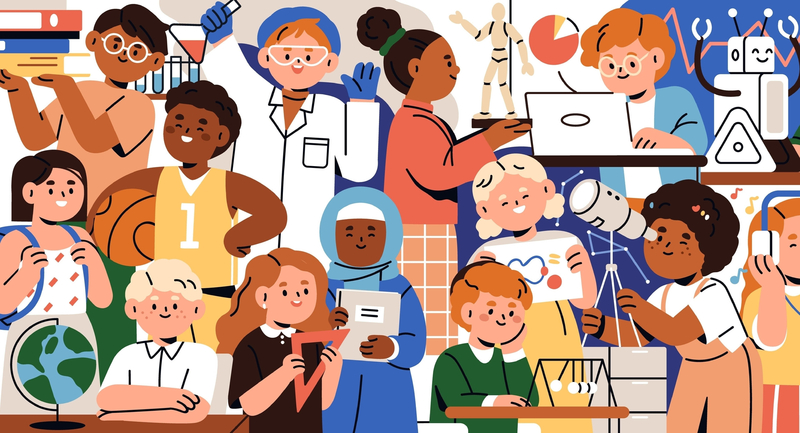Bertrand Russell (1975) once wrote, "To understand the actual world as it is, not as we should wish it to be, is the beginning of wisdom." His words are often quoted in the community-organizing world (where I worked for 19 years before becoming a teacher), and they're worth remembering when we plan and evaluate our instructional practices, including personalized learning.
"Understanding the world as it is" means being realistic. And if we're realistic, we'll know that even when a particular instructional method has been studied under controlled conditions, found to be effective, and labeled "best practice," none of that matters if students won't do the work. Teachers in the real world recognize that although personalization has the potential to improve learning, our first job in applying any approach is to engage students in the learning process. And engagement is not about baiting a hook. It's about helping students find their spark and make their own fire.
Researchers have identified four key elements that help develop this kind of student engagement (Ryan & Deci, 2000):
Autonomy is the amount of power students have to determine what they're doing and how they're doing it. Typically, the more autonomy students have, the higher their level of intrinsic motivation.
Competence, or self-efficacy, occurs when a student has the necessary skills to complete the assigned task successfully. "Growth mindset" notwithstanding, our students are not endowed with magical powers they can substitute for an adequate skill set. They won't be energized by banging their heads against a wall if they have no hope of breaking through.
Relatedness is created when students' actions result in developing closer relationships with those whom they like and/or respect. In the classroom context, this is often about achieving high-quality relationships with teachers, as well as connecting with their classmates.
Relevance means that students perceive the things we ask them to do as being in their own self-interest. Do the learning activities relate to topics that students are genuinely curious about? Do students believe that accomplishing the task or reaching the learning target will help them achieve a short-term or long-term goal?
Of course, in the real world, every lesson may not have a high concentration of all four of these elements. But speaking as a classroom teacher, I don't believe it's too much to expect that most of our lessons will have some degree of all of them.
When autonomy, self-efficacy, relatedness, and relevance are combined, they have a cumulative, synergistic effect. Students feel that they have (and in fact they do have) more power to proactively determine their life paths. This sense of agency, in turn, increases the likelihood that they will be able to transfer what they learn to other contexts—and will feel that at least some of the work they do in school matters outside the school walls.
As we strive to create personalized-learning environments for our students, it's essential that we keep these four elements of intrinsic motivation in mind. There are many ways in which we can capitalize on technology to weave engagement into our students' day—and there are also plenty of effective non-tech strategies. Let me describe a few strategies that I've found effective. Although I've applied these strategies with English language learners (ELLs), they can be equally useful for other students.
Researchers have found that providing different kinds of choice in personalized learning encourages autonomy (Goodwin, 2010). Stefanou, Perencench, DeCinto, & Turner (2004) identify three kinds of choice: organizational (for example, giving students a role in creating class rules or establishing due dates for assignments); procedural (for example, giving students a choice of media to present their ideas or of topics to study); and cognitive (encouraging student ownership of learning by asking them to justify or argue for their point, generate their own solutions, evaluate their own or others' ideas, and so on).
Non-tech example: I've experienced firsthand how even simple procedural choice can turn student motivation around. In one class, I asked students to write a persuasive essay arguing which natural disaster we had studied would be the worst to experience. Most students quickly got busy making their case—but not John, who had his head down on his desk. He had not done much work that semester, and he told me he wasn't going to do this assignment either.
From previous conversations, I knew John was an avid football fan. So I suggested, "How about writing an essay trying to convince me which is the best team in the NFL?"
"I could do that?" he responded in amazement. I told him yes, provided he used the graphic organizer the rest of the class was using, which highlighted the important elements of a persuasive essay.
He worked intently for the remainder of the period. As he turned in his essay, he asked, "Can I write one on the best basketball team to make up for some of the work I missed?" "Of course," I answered. Coincidentally, the next week there was a teachers' meeting with his mother. She had tears in her eyes as she held up John's essay with the A it had earned. She told us it was the first essay John had ever completed.
Tech example: Every Monday, ELLs in my Beginners English class complete a form on which they can identify anything they want to learn during their allotted computer time, as long as it promotes their language development. Students might write, "Learn eight irregular verbs and how to use them," "Learn more about the history of Mexico—in English," "Earn 600 points in Duolingo," "Learn 20 words related to food," and so on. At the same time, they choose how their learning will be assessed on Friday—by taking a test, giving a class presentation, creating a poster, composing and performing a short play, or another idea they have. For the most part, students research their topics using the wide variety of resources posted on our class blog, but they are free to explore the Internet and choose other resources. According to some researchers, this kind of cognitive choice (in which students have wide latitude in determining both what they learn and how they're assessed) can promote the highest levels of self-motivation (Stefanou et al., 2004). We feel competent when we know we have the skills necessary to successfully accomplish a task. Competent learners have developed the ability to accurately assess their current capabilities and the belief that they can expand them through work and study.
Non-tech example: One approach that I've found particularly effective in helping students feel they can be successful is to develop their metacognitive strategies. Having students establish individual learning goals and then identify which learning strategies work best for them are just two ways teachers can connect personalized learning to metacognition.
For example, like most literacy teachers, I teach such reading strategies as summarization, asking questions, and seeking patterns. I also provide questions designed to promote reading comprehension and sentence stems to help students develop their responses. After my students become familiar with the wide variety of strategies available, I ask each student to choose and apply the specific strategies and questions he or she thinks will be most helpful as we're reading a text. As a result, both the level of engagement and, I believe, the overall caliber of thinking and writing have improved.
I regularly ask students to complete anonymous surveys. Because transfer of learning (applying a concept you learn in one place to a new environment) is so important in education, I often ask what, if anything, they learned in my class that they apply elsewhere. Since I began giving students more choice about what reading strategies they use in my classroom, the percentage of students who reply that they are using these strategies elsewhere has increased dramatically.
Tech example: Online tools can help students reinforce their sense of competence by promoting risk-taking. Making mistakes in grammar, articulating new knowledge, or experimenting with pronunciation feels less scary when we know that our missteps will remain a secret between us and our computer.
My student Chang was a newcomer from China whose English was progressing rapidly in reading, writing, and listening. He was shy, though, and was almost completely unwilling to speak in English. I introduced him to the website English Central, which shows engaging closed-captioned videos, asks users to repeat the audio, and then automatically assesses their pronunciation. Within weeks after he began regularly practicing both at school and at home, Chang's confidence and the quantity and quality of his English speaking had increased so much that, on occasion, I joked that I regretted showing him the site! In fact, immediate feedback from a computer program can serve as a limited form of coaching—a crucial component of deliberate practice that supports mastery. There are plenty of free online tools that we can draw on to create a "choice menu" for students, giving them personal learning options for just about any subject imaginable (See "Online Tools for Personalized Learning: For ELLs and Others" on p. 33).
I'd offer one major caution about using technology to personalize learning and promote competence. Effective practice requires feedback and coaching. Such support might be adequately provided by a combination of feedback from the computer program and regular conversations between a student and teacher. But it also requires constant reflection by the learner on what he or she is doing right, could be doing better, and must do to improve enough to reach the next level.
Online tools seldom provide this reflective space, so we need to consider how we can make students' work on the computer more comparable to deliberate practice. With my Beginning English students, I provide a simple form that they can use, in combination with our one-on-one conversations, for goal-setting and reflection on their work online. It contains three questions:
(Before you log in) Today, I want to ___.
(At the end of class) Did I achieve my goal? (yes or no)
(At the end of class) These things helped me learn today, or didn't help me learn today: ___.
For example, after using the reflection form and thinking about additional questions we had discussed in class, Rodrigo realized that although he had enjoyed using a site filled with English-language-learning games the most, he had learned more when he used an independent reading tool that provided audio and visual support to help the learner access more complex text. His realization didn't mean that he never played the language games again, but he began spending more time—at home and at school—on the reading site to reach his goal of English proficiency.
In the context of intrinsic motivation, relatedness is about human connections. How can personalized learning help students feel more connected with others and feel cared about by people whom they respect?
Non-tech example: To enhance teacher-student relationships, I often take 15 minutes during my free period to walk, listen, and talk with individual students about their goals and interests. Many independent student projects, purchases of specific high-interest books, and important referrals to our counselor have come out of these conversations.
To enhance student-to-student relationships, we have a peer-mentoring system that's especially effective for our 9th graders. Older trained student mentors meet weekly with their mentees to build relationships, discover problems (both at school and at home), and offer advice. The mentors regularly strategize with teachers on how they can be most helpful.
Tech example: I discovered one way of using technology to develop relatedness entirely by accident. Although our school is committed to welcoming newcomers, and we have many classes specifically geared to them, there is often one class period each day when it's difficult to place these beginning English students in a regular learning environment until their English improves at least slightly.
During that class period, they're often temporarily placed in an independent study skills class in my room, working on computers while I'm teaching a different class. There aren't enough computers in this space, so the new students use an extension for their headphones to share the devices. At first I thought they would find this frustrating, but in practice, I see them constantly pointing at the screen and discussing the learning exercises they are using.
I haven't subjected these impromptu learning sessions to rigorous scientific study, but initial assessment results suggest that students who share the computers improve more rapidly than those who use individual computers. In fact, even though we've increased the number of computers in my classroom, some students insist on sharing because, as one student told me, "We learn better by helping each other."
Relevance occurs when students view school work as interesting and useful for improving their present lives or achieving their hopes and dreams.
Non-tech example: One lesson I often use in many of my classes has a particular tie-in to personalized learning. Students interview family members and acquaintances, neighbors and classmates, to identify issues of community concern. Through these conversations and classroom discussions about what they learned in their interviews, students determine a priority issue that they can take action on themselves.
Over the years, classes have organized job training fairs, mounted public outreach campaigns during the SARS epidemic, and helped educate cautious community members about the U.S. census and the need for people to answer the census questionnaires—just to name a few projects. Through such projects, students can gain a broader understanding of what "personalized learning" means. They realize that many of their personal interests and needs affect other people and that they often need to work with others to achieve positive results.
Tech example: All of the tech "personalized learning" activities described for autonomy, competence and relatedness can also support relevance to student interests and goals. Using the resources shown in "Online Tools for Personalized Learning: For ELLs and Others" and similar resources, I'm easily able to make learning English more personally relevant to each of my ELLs. Whether a student is interested in the construction, medical, or cosmetology fields, or loves to play soccer or basketball, or wants to study for a driver's test, within minutes I can copy and paste accessible links to pages designed to teach English that contain content about those topics.
Which Kind of Experience?
A veteran educator once told me that a key question we teachers need to consider is which kind of experience we want to create for our students: a prepackaged, antiseptic tour, or an adventure-filled journey where they often take the path less traveled and can't wait to see what they'll find around the next bend.
A similar question faces advocates of personalized learning. Will students be presented with a confining list of options based on what a computer program determines they should be interested in and capable of doing? Or can we view personalized learning more broadly to include both tech and non-tech strategies that facilitate student agency and expand the universe of learning possibilities?
There are no magic bullets in education—or just about anywhere else. But if we keep in mind the four key elements required for developing intrinsic motivation—autonomy, competence, relatedness, and relevance—we might be surprised at how much personalized-learning magic can actually happen in our real-world classrooms.
Online Tools for Personalized Learning: For ELLs and Others
These online tools provide self-paced materials, and some are adaptive (modifying what students see on the basis of their responses). All allow teachers to create virtual classrooms so that they can monitor student progress.
Duolingo is probably the most popular language-learning online tool today. Many languages are available. (Free.)
USA Learns is an internationally used site for learning English. It is sponsored by the Sacramento County Office of Education. (Free.)
English Central lets users see videos, re-record the audio, and then assesses the accuracy of their pronunciation. (Many resources are free, although premium content is also available.)
Raz-Kids provides "talking books" at multiple levels that speak the text at the same time the words are highlighted. There's a wide range of fiction and expository text. ($90 annually for one classroom of students.)
ReadWorks has multiple texts with online assessments. (Free.)
Newsela provides several "levels" of the same newspaper articles, along with some online interactives. (Content is free, although there is a cost for creating a virtual classroom.)
Tween Tribune is from the Smithsonian and also offers several levels of the same newspaper article, along with quizzes. (Free.)
CommonLit provides thematic reading collections with writing prompts. The site is planning to expand substantially over the next year. (Free.)
iCivics provides many social studies-related games and online activities, including ones targeting primary sources. (Free.)
ScootPad has many online lessons on multiple subjects. (Free, but offers many additional premium features with a cost.)









